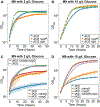Systems Metabolic Engineering of Escherichia coli Improves Coconversion of Lignocellulose-Derived Sugars
- PMID: 31297978
- PMCID: PMC6718303
- DOI: 10.1002/biot.201800441
Systems Metabolic Engineering of Escherichia coli Improves Coconversion of Lignocellulose-Derived Sugars
Abstract
Currently, microbial conversion of lignocellulose-derived glucose and xylose to biofuels is hindered by the fact that most microbes (including Escherichia coli [E. coli], Saccharomyces cerevisiae, and Zymomonas mobilis) preferentially consume glucose first and consume xylose slowly after glucose is depleted in lignocellulosic hydrolysates. In this study, E. coli strains are developed that simultaneously utilize glucose and xylose in lignocellulosic biomass hydrolysate using genome-scale models and adaptive laboratory evolution. E. coli strains are designed and constructed that coutilize glucose and xylose and adaptively evolve them to improve glucose and xylose utilization. Whole-genome resequencing of the evolved strains find relevant mutations in metabolic and regulatory genes and the mutations' involvement in sugar coutilization is investigated. The developed strains show significantly improved coconversion of sugars in lignocellulosic biomass hydrolysates and provide a promising platform for producing next-generation biofuels.
Keywords: adaptive laboratory evolution; constraint-based modeling; metabolic engineering; sugar coutilization.
© 2019 WILEY-VCH Verlag GmbH & Co. KGaA, Weinheim.
Conflict of interest statement
Conflict of interest
The authors declare no financial or commercial conflict of interest.
Figures





Similar articles
-
Simultaneous utilization of glucose and xylose via novel mechanisms in engineered Escherichia coli.Metab Eng. 2015 Jul;30:141-148. doi: 10.1016/j.ymben.2015.05.002. Epub 2015 Jun 2. Metab Eng. 2015. PMID: 26045332
-
Systematic approach to engineer Escherichia coli pathways for co-utilization of a glucose-xylose mixture.J Agric Food Chem. 2013 Aug 7;61(31):7583-90. doi: 10.1021/jf401230r. Epub 2013 Jul 25. J Agric Food Chem. 2013. PMID: 23848609
-
Multiplex growth rate phenotyping of synthetic mutants in selection to engineer glucose and xylose co-utilization in Escherichia coli.Biotechnol Bioeng. 2017 Apr;114(4):885-893. doi: 10.1002/bit.26217. Epub 2016 Dec 15. Biotechnol Bioeng. 2017. PMID: 27861733
-
[Metabolic engineering for the efficient co-utilization of glucose and xylose].Sheng Wu Gong Cheng Xue Bao. 2024 Aug 25;40(8):2710-2730. doi: 10.13345/j.cjb.240199. Sheng Wu Gong Cheng Xue Bao. 2024. PMID: 39174478 Review. Chinese.
-
New insights into transport capability of sugars and its impact on growth from novel mutants of Escherichia coli.Appl Microbiol Biotechnol. 2020 Feb;104(4):1463-1479. doi: 10.1007/s00253-019-10335-x. Epub 2020 Jan 4. Appl Microbiol Biotechnol. 2020. PMID: 31900563 Review.
Cited by
-
Minireview: Engineering evolution to reconfigure phenotypic traits in microbes for biotechnological applications.Comput Struct Biotechnol J. 2022 Dec 24;21:563-573. doi: 10.1016/j.csbj.2022.12.042. eCollection 2023. Comput Struct Biotechnol J. 2022. PMID: 36659921 Free PMC article. Review.
-
Adaptive Laboratory Evolution of Microorganisms: Methodology and Application for Bioproduction.Microorganisms. 2022 Dec 29;11(1):92. doi: 10.3390/microorganisms11010092. Microorganisms. 2022. PMID: 36677384 Free PMC article. Review.
-
Current models in bacterial hemicellulase-encoding gene regulation.Appl Microbiol Biotechnol. 2024 Dec;108(1):39. doi: 10.1007/s00253-023-12977-4. Epub 2024 Jan 4. Appl Microbiol Biotechnol. 2024. PMID: 38175245 Free PMC article. Review.
-
Engineering the Metabolic Landscape of Microorganisms for Lignocellulosic Conversion.Microorganisms. 2023 Aug 31;11(9):2197. doi: 10.3390/microorganisms11092197. Microorganisms. 2023. PMID: 37764041 Free PMC article. Review.
References
-
- Parreiras LS, Breuer RJ, Avanasi Narasimhan R, Higbee AJ, La Reau A, Tremaine M, Qin L, Willis LB, Bice BD, Bonfert BL, Pinhancos RC, Balloon AJ, Uppugundla N, Liu T, Li C, Tanjore D, Ong IM, Li H, Pohlmann EL, Serate J, Withers ST, Simmons BA, Hodge DB, Westphall MS, Coon JJ, Dale BE, Balan V, Keating DH, Zhang Y, Landick R, Gasch AP, Sato TK, PLoS One 2014, 9, e107499. - PMC - PubMed
MeSH terms
Substances
Grants and funding
LinkOut - more resources
Full Text Sources

